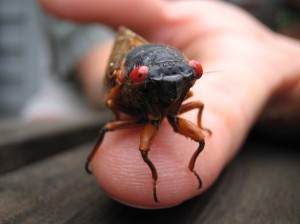 The first time I experienced “cicada mania” was in 2004.
The first time I experienced “cicada mania” was in 2004.
We’d just moved to the East Coast and were getting used to living and working in the DC area. And in all the advice people had to give us about our Eastward move, somehow they forgot to tell us that every few years, we’d feel like extras on the set of a B-grade thriller from the 50s.
Image: Wikimedia Commons
At least, that’s how I felt when I opened my front door one summer’s day that year. Unsuspecting as to the horrors that awaited outside, I literally screamed and jumped back inside the house when I saw every visible surface covered with the brown things. And I do mean Every. Single. Surface. That. Was. Visible. From the door frame, to the stoop, to the walkway…
Cicadas, everywhere, cicadas
In my memory, that period lasted forever. Which, of course, it didn’t, but for the time, it seemed cicadas ruled our lives.
The Washington Post published cicada recipes with relish [sic]. I started carrying an umbrella to try and keep them off my head whenever I went out (I think one got into my hair one time; I was not pleased). Our dogs gorged on them with delight every time they went out in the yard; sometimes they’d even have cicada bits sticking out of their mouths. It was disgusting.
That was Brood X, apparently. This year, Brood II – one of the types of 17 year cicadas – is slated to emerge from the nether regions and terrorize us all for several weeks, if not literally, then with the excruciatingly loud chirping we won’t be able to get away from.
My husband tells me that our particular area may get spared; I haven’t as yet found anything online that supports that assertion, yet still, one can hope.
Oh wait! I might have…
PR tips from periodical cicadas
If you’re looking for PR inspiration, though, the periodical cicadas should give it to you in droves.
1. Let’s talk about sex, baby
To start (and end) with, it’s all about sex. They emerge from their years-long hibernation only to procreate. To make matters more interesting, they die as soon as they’ve done so. Then their offspring bury themselves, emerge 17 years later, and do it all, all over again.
Tip: Sex makes for a great story. Always. Just be smart and keep your stories SFW (safe for work) and relevant; without the sex angle, the periodical cicadas wouldn’t be a story. That means, if it’s not relevant, don’t try to make it so!
2. The numbers game
If these cicadas emerged in less-than-pestilential numbers, no one would pay attention to them. As a matter of fact, they do, every year, and we don’t. But these particular broods clearly know there is strength in numbers (one of the reasons they are thought to emerge so dramatically ever so often, to avoid predators chomping down enough of them so as to eat them into extinction). And enough of us are affected by them so as to pay attention.
Tip: a movement rarely comprises just one, or a few, people. And it’s rarely attention-worthy until it’s something huge numbers of us can get up in arms about.
3. Making a difference
Ever since scientists and naturalists and all the other -ists have been able to track periodical cicadas, they’ve been trying to explain why this happens. Explanations range from them possibly being a food source (so that’s your “cycle of life” angle), to playing a part in soil ecology (that’s your “Inconvenient Truth” angle), to natural tree pruning (that’s your botany angle). What they all have in common is somehow making a difference, usually positively, to life as we know it.
Tip: if your story has a cast of characters and/or plot that makes a real difference to life as we know it, you probably have a winner on your hands.
4. Appearances matter
I dare you to find an article, or blog post, or TV story, about Brood II (or X, or any brood) that doesn’t mention their “bulging red eyes.” The cicadas’ emergence would still be noteworthy even if they weren’t, er, “arresting” in their appearance, but the fact that they are really makes people stop and pay attention to them.
Tip: appearances do matter, and sometimes first impressions can mean the difference between your story being picked up, or at least being shortlisted for further review, and not.
5. Good stories have angles, and legs
Look at the way the media are going crazy over the cicadas. I talked about how I remembered cicada recipes from the last time we had such an invasion, and this year is no different (though please note the P.S. on their mercury levels). If you feel like playing detective, well, this one’s for you courtesy Radiolab and WNYC. The National Geographic-sponsored Magicicada.org is going strong, and will likely continue to do so, as has been, and will, CicadaMania.com.
Tip: does your story have several different angles? Does it have enough “there” there to be sustained over time?
As I said earlier, I’m not particularly enamored of these little beasties, but that doesn’t stop me from appreciating what they can teach us. I’m sure there are several PR (and, perhaps, other) lessons I haven’t even touched on yet… what do you think we can learn from them? Do share your thoughts… and if you’ve experienced the magicicadas in the past, what did you think? Are you looking forward to the 2013 visitation?
As for me, I’d better put my hammock away until the creatures have crawled back into the ground. Maybe then I can enjoy the rest of the summer.
![[EVENT]: PR Hacks for Small Biz (online)](https://shonaliburke.com/wp-content/uploads/2021/06/FB-Ad-1200x800-01-01-01-Copy-500x383.jpeg)








We had the 13-year cicada’s here (in Southeast Missouri) in 2011. You couldn’t sit outside the noise was so awful–people even changed outdoor weddings and the like to indoor venues!
Oh, and love the PR analogy :)
tressalynne It is just incredible to me how far they go. Crazy! And thank you, Tressa!
[…] good service + finding a creative hook for the customer experience = smart public relations. And I bet the salon didn’t even think it was engaging in “PR”… but it […]
That’s one hell of a sex party. Sweeping up the carcasses with a broom after the fact is always an odd moment. Sorry, I couldn’t help myself.
geoffliving HAHAHAHAH!!!!
Create lots of buzz…
JohnFriedman Oh that’s AWFUL!!!!!
Eek! I only have to deal with cricket infestations. I don’t think I’d like cicadas at all, at all.
Lovely tips, Shonali – and quite memorable.
Erin F. I thought the crickets were bad too, until I had to deal with the cicadas. Ugh!
I am pretty sure they aren’t up here in Vermont. I never missed them in Los Angeles. I have had them fly full force into me and they hurt. When cycling at speed they can leave welts. And that noise! OYE! But hey we have lots of mosquitos, back flies and deer flies up here. Trade a few flying rocks for those any day!
Great tips btw Shonali
Howie Goldfarb You had them in LA? Really? They get around, don’t they?
The noise is excruciating. I’ve already told granthillfit that once the cicadas come, our outdoor workouts will be curtailed until they’re safely buried and I’m not walking on them…
My skin is crawling at the thought. May my Brooklyn borough be mostly spared! Great tips though! Thanks Shonali :-)
katskrieger So my husband insists that this year they’ll be confined (mostly) to Southern Maryland… I hope he’s right, but I’m not counting on it. I don’t think they’ll go as far north as Brooklyn, though I haven’t looked at the map carefully enough.
Oh, I forgot to mention how you’d find them in the dogs’ poop as well. Disgusting.
This is absolutely priceless, Shonali!!! I am laughing so hard…wow, do I remember 2004, I thought my ears would ring the rest of my life!
CarolHamptonRasco just you wait Carol! I saw on the editorial calendar for early June ‘How the mating habits of Cicadas are like Social Media’ ;-)
Howie Goldfarb I’m gonna make YOU write that post. ;P CarolHamptonRasco
CarolHamptonRasco I could not BELIEVE my eyes (or ears). We’d left California… for this?!
I’m glad I made you laugh, Carol. Aren’t we due or, rather, overdue to catch up?